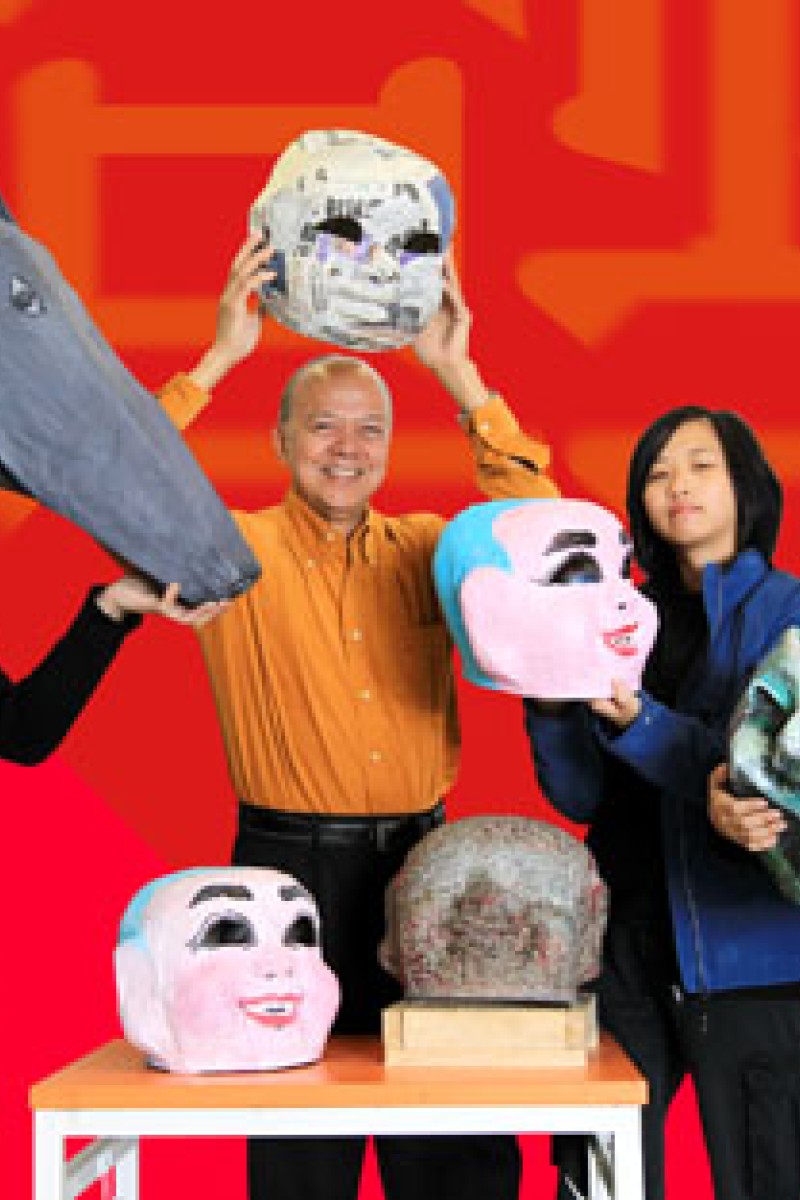 Master Paul Chan Lai-cheung (second left) with HKICC Lee Shau Kee School of Creativity students (From left) Lo Kwan-long, Tsui Yu-ting and Chan Hoi-yu. They show off their creations they made with a technique Chan taught them.
Master Paul Chan Lai-cheung (second left) with HKICC Lee Shau Kee School of Creativity students (From left) Lo Kwan-long, Tsui Yu-ting and Chan Hoi-yu. They show off their creations they made with a technique Chan taught them.Leading the dance on the street is a playful Big Head Buddha, who teases and taunts the lion along the way with its palm-leaf fan.
Paul Chan Lai-cheung is pleased. The 60-year-old is one of the few masters in Hong Kong who can craft a traditional Buddha head from scratch. And he does it all by hand.
He sticks six to seven layers of wet newspaper onto a cement mould carved in the shape of a Buddha head. Once the paper is dry, he skilfully peels the paper mask off and reinforces it with wire and bamboo.
He then cuts the eyes, polishes the head with powder and glue, and paints a pink smiley Buddha face with a blue hair line.
"It's been a family tradition," Chan says. He learned the craft from his father, now 90, who once worked in a paper shop in Central, making dragon and lion heads.
The Big Head Buddha, better known as Da Tou Fut in Cantonese, plays the role of a comical clown in a lion dance.
Dressed in monk's robes and wearing the mask of a laughing Buddha, the performer taunts the lion while dancing to the rhythm of the drums and gongs.
From the age of 10, Chan began helping his father make Buddha heads. Each head sold for around HK$40, which could buy some decent meals in the 1970s.
At 10pm, when his father returned home after 11 hours at work, the family became a tiny "factory." "Everybody had a role, be it cutting, gluing or painting. I miss those days," he says.
These days almost 90 per cent of Buddha heads are mass-produced on the mainland. Chan seeks to preserve the tradition of making each by hand. He is passing on his skills to students.
Tsui Yu-ting, a sixth former at HKICC Lee Shau Kee School of Creativity, is one of the master's students. Yu-ting, a visual art student, has created a white-and-blue robot head using the traditional method. "Who says the tradition should be all about old stuff?" he asks.
Fish Chan Hoi-yu, 18, has created an alien mask worthy of a Hollywood movie. "Master Chan is such a great teacher," she says. "It's hard to believe a traditional art can be some much fun."
Yet Chan frowns upon some of his students' work: Bomberman from a video game, a yellow duckling head, a medieval knight helmet. Then he adds with a smile: "It's where the East meets the West, the old meets the new."
Masks inspired by video games and science fiction films are a far cry from ancient traditions. Yet Chan admits his students' creativity surprises him. Their creativity helps "revitalise an old tradition" and keep it relevant, he says.
"I'm sure my 90-year-old father is excited to know the younger generation still loves the art and spirit of the Big Head Buddha," the craftsman says.
Want to make a Buddha head? Join the workshop which will be held at HKICC Lee Shau Kee School of Creativity later this month. You can find out about more activities through the Young Post Reporters' Club at www.scmp.com.
